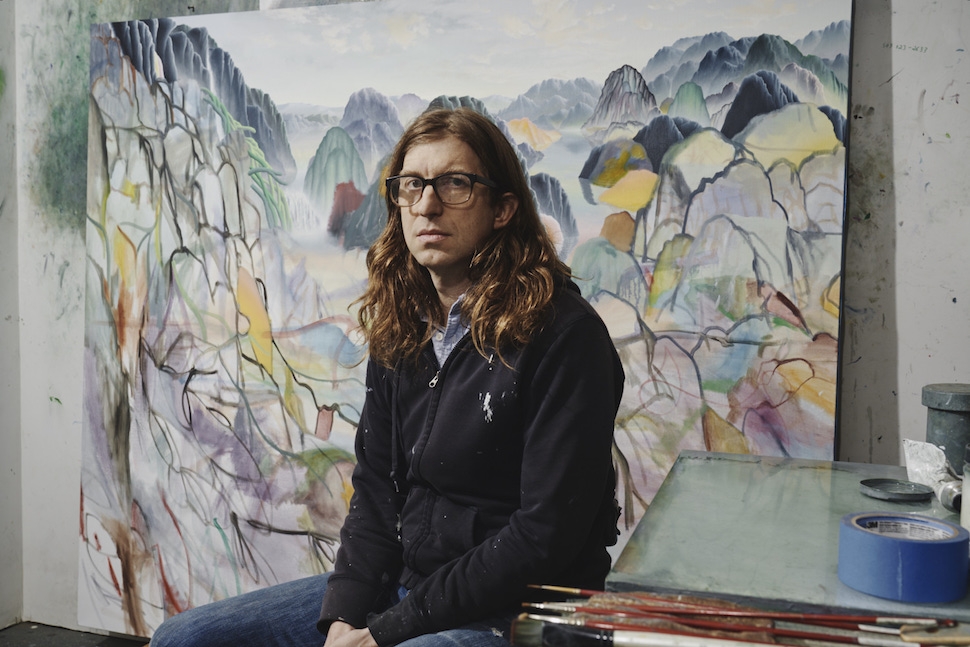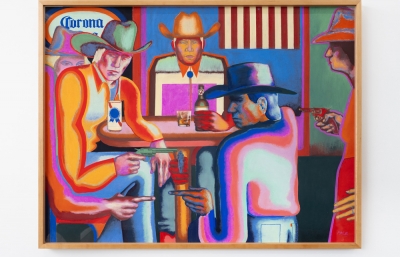Adam Sorensen
The Electric Light Landscape
Interview by Gabe Scott and portrait by Clayton Cotterell
Adam Sorensen has established himself as a torchbearer for traditions of landscape painting and its vitality within a contemporary context. Steeped in a broad scope of art history, Sorensen references a variety of Asian and European movements, while injecting unique personal interpretations blurring eras, but in renderings keenly aware of the spiritual connection landscape painting offers. Sorensen crafts a spellbinding, allegorical realm, inviting the viewer to participate.
Sorensen’s fantastical worlds are created through vertical and horizontal grid-like structures of light and dark shapes, forming tantalizing patterns that entice the eye. A smooth veneer and graphic sensibility seal the panorama of soft-edged forms into the periphery, while prismatic inserts provide radiant support. Each landscape expands through a series of fractal reactions, unfolding each new detail in response to the previous. There is a rhythmic quality to the evolving, echoing patterns as they reassemble themselves to emphasize the upward inflection of their grand arrangements. The juxtaposition of cool overtones and warm undertones throb softly within the image, delivering a pulsating vitality that transforms the entire vista into a living, breathing organism.
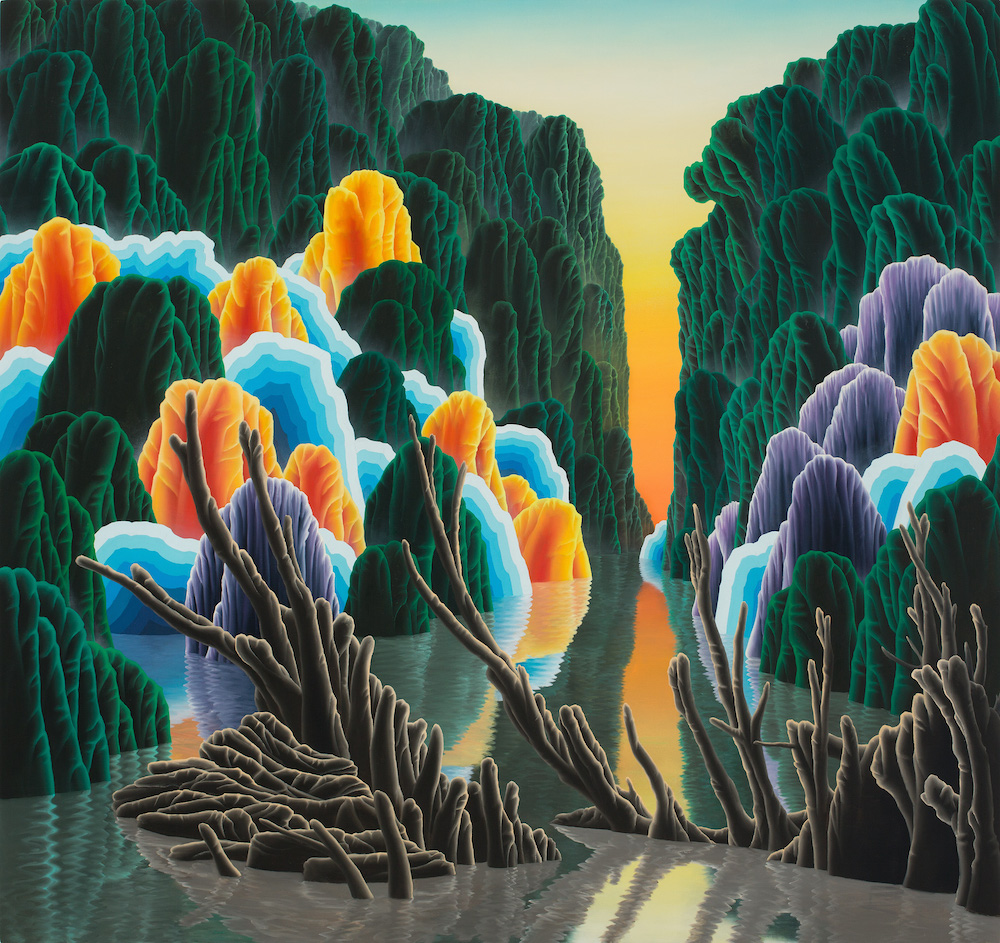
These expansive vignettes are influenced by Adam's interaction with the natural world, as well as his enthusiasm for old reference books. Ambiguity is an important aspect of Sorensen’s earthly allusions, and at their core, his paintings are built on abstract emotion, rather than an explicit narrative. Bathed in a vibrant energy and soaked in sumptuous chromatics, these environments are energy fields of density and optical resonance. Light possesses a vaporous quality, which somehow oscillates somewhere between an infrared haze and the residue of a psychedelic sunset.
Beneath the surface, there lies both a prevailing sense of peace while acknowledging conflicting emotions in ourselves and the world around us. These scenes of symbolic vernacular establish a profound connection to the heart and mind, with a mirror that offers guidance in reflecting the complexities of modern life.
These transcendental paintings serve as dynamic theater for a subjective, organic contemplation that can reflect the spiritual yearning of a viewer. They straddle a certain duality, offering open-ended questions about whether each vignette signals genesis or epilogue. As the information age unravels the threads of our culture, Sorensen dives into a deep chasm to someplace else, built on the idea of achieving and preserving an atmospheric serenity and calm that offers relief from the anxieties of our rapidly expanding universe.
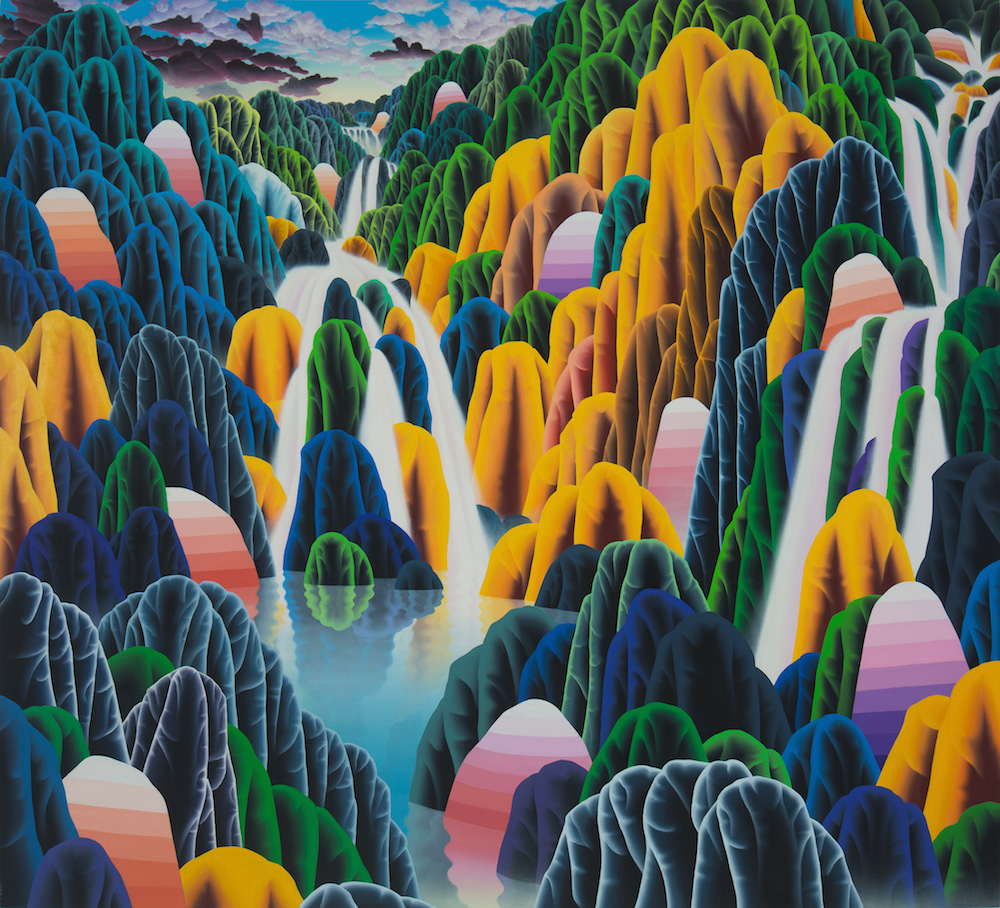
Gabe Scott: For the better part of the past decade, these mysterious, alternate landscapes have been your domain. Are you content in this sphere, or do you feel compelled to strike out in a different direction?
Adam Sorensen: It has been going on in my mind for a long time now, and yes, at times, I hunger for something new. However, there hasn’t been any output to speak of, at least of something new altogether. At some point, the world kind of expects a certain thing of you, and sometimes I feel compelled to follow those tendencies. The world seems to want what I’m good at doing. With that expectation, there’s a give and take. All of a sudden, I might think to myself, “Wait a minute, this isn’t just me,” and you sort of break yourself out of that rut or groove. Maybe that groove has become a rut?
When you are following intuition down a new or exploratory path, does it tend to provide you with a sense of freedom? Or do you find yourself more tentative in your improvisation?
When I speak of grooves and ruts specifically, I am talking about fighting my own inclinations. For years, when I’ve talked about my process with people, I’ve explained that I work from the top of the painting to the bottom. Then, I work my way down, and work from the back to the front. There are real beginnings and endings in each. It’s been really great, in a way, because I can say, ”This is my process. I’m going to execute my process, I’m going to look at my painting, and there you have it.” Slowly, the improvisation can dwindle; there’s less and less there. I’ve been seeing sort of a staleness start to come in. So, in terms of progress, it's very much about challenging those rules and upsetting that process without tipping the boat entirely over.
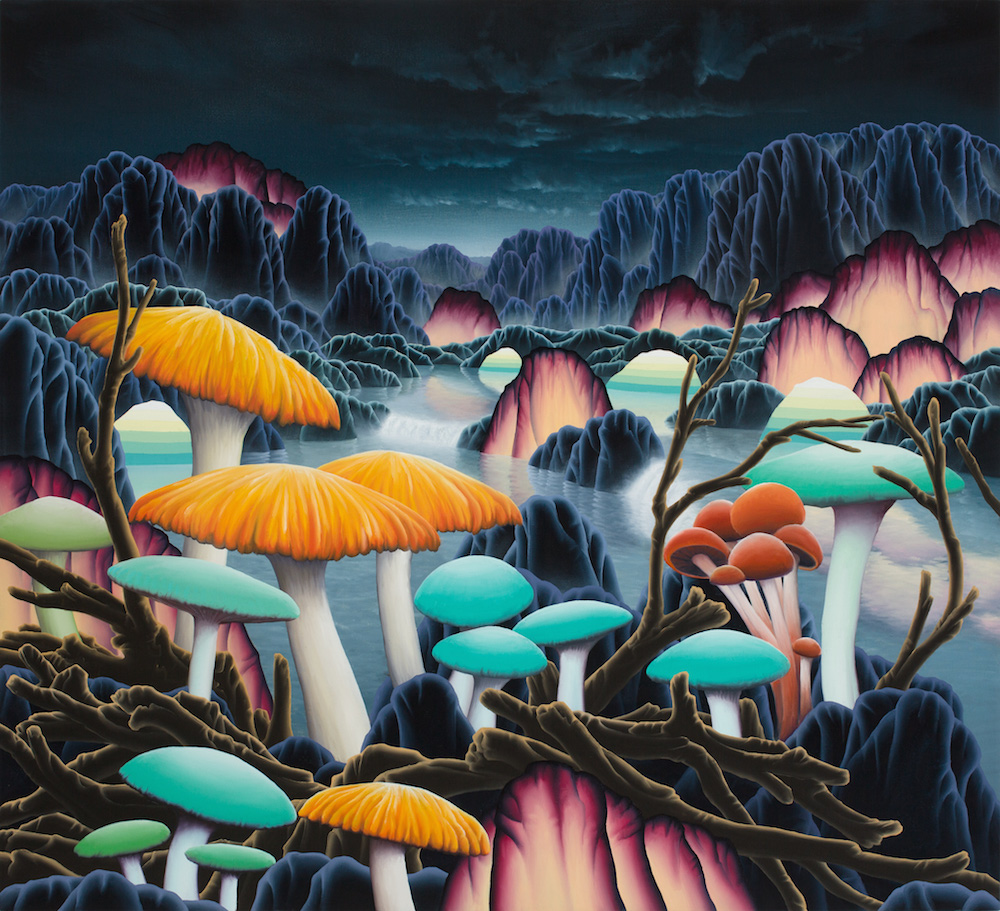
When considering new dimensions to your work, I imagine there's no need to eradicate the established foundation, but finding a balance can foster personal growth and encourage conceptual evolution. Have you always worked top to bottom, back to front, as a framework?
Once I really established this particular motif, it was all about honing. As soon as I started doing this, the focus shifted to, “How can I do this better? How can I do this more efficiently?” For years, it was all about the process. For close to ten years now, I'd say. There’s something I really love about honing a point of emphasis and sharpening a specific skill. It has always been landscape painting, but the “real” wasn’t there, in a literal sense, right in front of me. It has always just existed in my head. It really was just born out of that process that I developed. At times, it is still very rigid, but my process is my process.
How did working in three-dimensional mediums direct you towards painting, or at least inform the kind of painting you are doing now?
I’ve always struggled to answer that question. I think the reason I started painting was that those things alone just weren’t doing it for me. I studied at The School of Design at Alfred University in New York. That experience was really three-dimensionally centered, and during my time there, I got pretty into working with hot glass. I also worked with sculpture and ceramics, but they didn’t seem to do it for me the same way that painting does.
Once I focused on painting, it all felt so direct and so much more like the right thing for me. So those other mediums, in a way, got me creatively juiced up, but I never felt satisfied with what I made. They’re so craft-based that I thought, “Do I want to spend my whole life trying to make the perfect goblet?” I just couldn’t see that future. However, I was way into the different powders and pigments that were available to me. My exposure to those things helped shape the way I operate, when painting, to use every color on the table. In both contexts, my imagination works in a similar manner.

In so much of your work, the color really pops, but they are also hot and cold colors existing simultaneously without a head-on collision. The manner in which they are able to coexist in the same frame is one of the more electric things about your execution. They all have that kind of energy, with precipitous examples that draw from the natural world. At times, the canvases themselves seem to emit bioluminescent qualities.
There’s a sort of drama that is inherent in the waterfalls, for example. The point where water and rock make contact—the crossover of elements, essentially. That is where the gradient occurs, literally. It’s also this sort of weird, ambiguous place where the sun hits in particular striking kind of way that inherently generates this drama. Sort of like the period where things go from day to night. It’s just something about transitional moments, fire coming out of the ground. It seems to emphasize that there is this ambiguity to it all.
There has been a common assessment of your work that the imagery suggestively leans toward being either a utopian or post-apocalyptic view. When I say post-apocalyptic, that doesn’t necessarily mean dystopian or carry a negative connotation. Regardless of that, are you developing these landscapes primarily from your imagination? What do you use for source material? Is it something you’ve seen in real life that you’ve taken note of and you’re transforming into the stylized world you create?
At this point, they’re completely out of my head. When I first started down this road, I was pulling a lot of references from other landscapes, Time Life-style books, and from the semi-anonymous photographers working for those publications in the ’70s. There would be this kind of perfect, sublime shot, and I’d pull out various aspects with which to improvise. If I could just get the feel of something, I could produce this vista—I can sort out this mountain peak here, have kind of an alternate perspective there. It sort of felt like collage, or maybe visual sampling, because I was pulling from so many things. I loved Japanese printmaking and other nineteenth-century painters, like Frederic Church, Thomas Cole and the Realism of those landscape paintings. With that collage approach, I was getting all these weird, inordinate perspectives, and there was no Renaissance three-point perspective happening. It was all kind of janky, but I loved that part of it, too. I just kept going with it, and trusted my instinctual perspective, but it was completely imprecise.

I think when you look at the ambiguity of the utopian and dystopian aspect of things, it could either be the end or the beginning. The context feels like both a genesis and the prelude to an end, with nothing definitive about either direction.
That’s something I’ve thought about a lot. I intentionally omit any sort of figure, animal or anthropomorphic reference. The exception being incorporating some sort of plant life, recently in the form of mushrooms. When I was first integrating that aspect, it was suggesting that this scene was a time before humans. It felt like a reference to the primordial soup period of Earth's development. But, what you’re alluding to, that’s exactly what I've hidden in the work. I've always loved Caspar David Friedrich's painting, Wanderer above the Sea of Fog. It features an Elizabethan gentleman standing in awe at the edge of a cliff overlooking a dramatic but ominous landscape. With that painting, the anonymous figure surveys the landscape and the sublime spectacle of it all. Maybe this is a little cheesy, but in my work, I always think of the viewer essentially being that figure.
In your last few exhibitions, I noticed a new emphasis on texture. Viewing those details up close—the incorporation of the clouds, skies, reflections and your renewed focus on other elements besides water and rock—provided another layer of depth and dimension to an expanded picture plane. The palette in Zebulon, for example, actually reminded me of Georgia O’Keeffe’s work.
Totally! She has definitely bounced around in my paintings, where I’ve thought to myself, “I am in that world.” Very warm and moist. I don’t mind that comparison at all. There’s a school of Canadian painters from that era that I also find captivating. Lawren Harris and the Group of Seven were pretty out there, but you can find that same sort of treatment of paint as you’d see in the ’30s and ’40s. I do tend to reference him, and he’s been a huge influence. Sometimes I’ll jump into his book when I’m feeling uninspired, and I’ll just stare at some of his paintings.
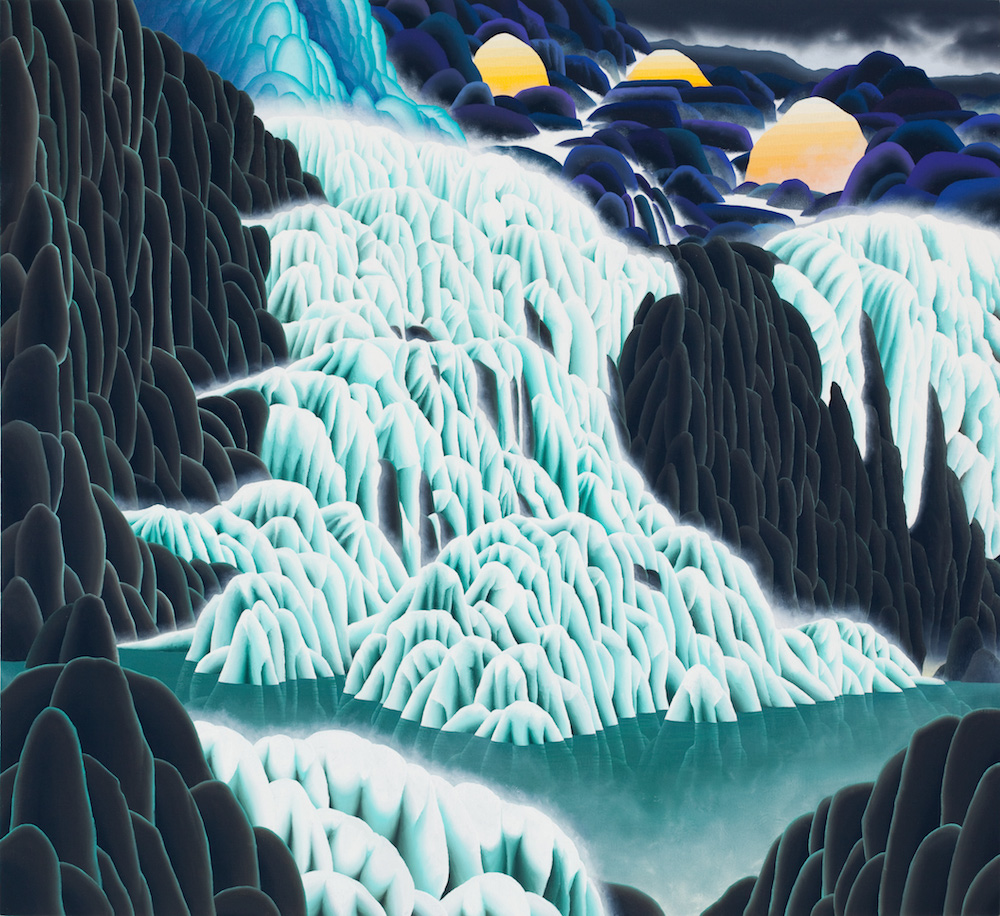
Finally, what can you say about the landscapes and environments you cannot commune with directly? Places that you've only been able to visit through books, maps or the internet? As we see unprecedented growth in urban areas and attempt to preserve a dwindling amount of open space, it is certainly plausible that the ideas and traditions of landscape paintings might become even more dependent on visual sampling and encyclopedic reference. Can you compare the way you establish a connection to landscapes you have discovered through research, as opposed to the first-hand experience?
I think of these examples of historic landscape art as well as other sources of landscape imagery as my primary subject matter. This sets the foundation of my work on more of a shared cultural platform so that people see and feel the history and nostalgia of the work in my paintings. I’ve experienced moments of the sublime from these images, in much the same way as I have in nature itself. I’ve committed to creating an invented landscape, and my building blocks consist of art history, pop culture, and other things in my life that have generated enthusiasm.

